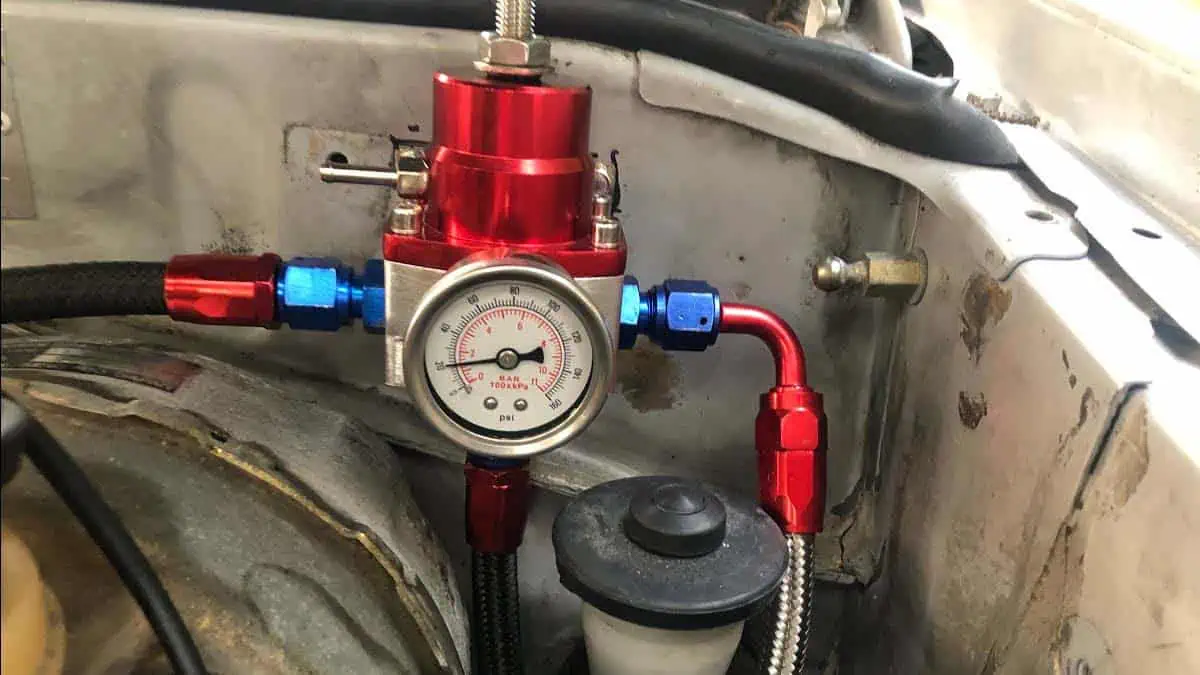Cars are complex machines that require every component to work together to create a smooth, safe ride. Though many drivers know the most common auto parts and their functions, problems sometimes arise with lesser-known auto parts.
Fuel pressure regulators, for example, can affect several aspects of the car’s performance. These devices are essential because they significantly affect how a vehicle operates. A bad or faulty fuel pressure regulator could leave you stranded or put you in danger on the road.
Learning the symptoms of a bad fuel pressure regulator is necessary to know when to take your vehicle to an auto mechanic for repair. The guide below outlines everything you should know about fuel pressure regulators and their common signs of trouble.
10 Common Signs Of A Failing Or Faulty Fuel Pressure Regulator
Below are the most common symptoms of a bad fuel pressure regulator, though other vehicular issues and faulty components can produce similar warning signs.
1. Weak Acceleration
When you press your foot lightly onto the gas pedal, you expect your car to speed up immediately. If your vehicle has a bad or faulty fuel pressure regulator, your car won’t move faster despite depressing the accelerator.
If your car struggles to gain speed, it’s reasonable to assume the fuel pressure regulator is at fault. The problem is likely due to the engine’s inability to get the right mixture of air and fuel.
2. Reduced Fuel Efficiency
A failing fuel pressure regulator will reduce your car’s fuel efficiency to detectable levels. A bad regulator will force the engine to use more fuel than it should to generate enough energy to move the vehicle.
The fuel’s flow into the cylinders will slow down when the regulator doesn’t produce sufficient pressure. As a result, the engine will overwork and consume extra energy to compensate for the lack of pressure.
The change in fuel economy means you’ll spend more time and money at the gas pump. The car will have fewer miles per gallon, and you’ll notice a general performance reduction.
3. Black Smoke From Tailpipe
Your exhaust tailpipe should always emit white or gray smoke. The smoke is mainly water vapor.
Black smoke is one of the primary symptoms of a bad fuel pressure regulator. It means the engine is consuming excess fuel.
Black smoke from the exhaust tailpipe could be due to other problems beyond a bad fuel pressure regulator. For instance, it could indicate a clogged air filter or damaged fuel injectors.
4. Fuel Leakage
A reduced fuel economy can stem from a fuel leak. A leak and poor fuel economy are likely the result of a failing fuel pressure regulator.
The fuel pressure regulator has seals on either side to contain the fuel. Over time, the seals can weaken or deteriorate, leading to fuel leakage. A continuous leak will force the engine to consume more gasoline, but the car’s performance will decline, not improve.
Leaks within the fuel delivery system can also arise from contaminants or a clogged fuel filter. Electrical connections can also cause this problem.
A fuel leak is a major safety risk, regardless of its cause. Seek professional assistance as soon as you realize your car is leaking fuel.
5. Deceleration Problems
Acceleration problems aren’t the only speed-related indicator of a faulty fuel pressure regulator. Your car might also struggle to reduce speed.
Deceleration problems can occur if gasoline backs up into the engine. The extra fuel continuously triggers combustion within the motor. The car will maintain the same speed even if you remove your foot off the gas pedal.
Deceleration problems are extremely hazardous. If you fail to slow down while driving at high speeds, you could cause an accident.
6. Engine Won’t Start
People often assume a drained battery or failing transmission is why their cars won’t start. However, a defective fuel pressure regulator can prevent a car’s engine from turning over.
When you turn the car key to start the ignition, a functional fuel pressure regulator will ensure that the appropriate pressure level is present to start the engine. A severely damaged regulator won’t produce enough pressure to start the car, even if you hear it crank.
7. Engine Misfires
An engine misfiring sounds like a loud pop similar to a gunshot. Many factors contribute to an engine misfire, making it a common symptom of several issues, including faulty fuel pressure regulators.
If the fuel pressure regulator is the culprit behind a misfiring engine, the engine won’t run smoothly while idling. You will feel strong vibrations from under the hood.
The car’s rough operation is due to insufficient fuel flowing into the combustion chambers. The air-to-fuel ratio will be incorrect, leading to a decline in the vehicle’s performance.
8. Noisy Fuel Pump
You will likely hear your fuel pump while driving, even if you can’t pinpoint the sound among background noise. An intense whirring noise could indicate a problem with one or more of the engine’s components, including the fuel pressure regulator.
An improperly functioning fuel pressure regulator won’t have a proper fuel flow through the pump. This situation can change how the pump performs, leading to a loud whining or whirring noise.
You can hear the fuel pump when you start the car or press the gas. If it’s too loud, a car expert should check the fuel pressure regulator.
9. Blackened Spark Plugs
Check the car’s spark plugs if you suspect your vehicle has a bad fuel pressure regulator. If the regulator is failing, the spark plugs will have blackened or sooty tips.
Spark plugs darken because of a higher concentration of fuel in the air and fuel mixture. The soot consists of carbon deposits. It’s best to replace the spark plugs to avoid further car issues, like black smoke from the exhaust tailpipe or engine misfires.
10. Gasoline-Filled Vacuum Hose
An obvious sign of fuel pressure regulator troubles is fuel in the vacuum hose. The hose connects to the side of the fuel pressure regulator. If the regulator fails, gasoline from the device can seep into the vacuum hose.
You can check your vacuum hose for signs of gasoline by disconnecting the component from the fuel pressure regulator and inspecting its interior. You might also see fuel dripping from the regulator onto the hose after the engine turns on.
What Is A Fuel Pressure Regulator?
A fuel pressure regulator is an auto part that controls the fuel pressure levels within an engine. Many cars have a direct fuel injection, which delivers fuel straight into an engine’s internal combustion cylinder. The regulator determines the fuel pressure the injectors need to move the vehicle at specific speeds.
If a car doesn’t have an electric fuel injection system, the gasoline must mix with a certain amount of air to ignite within the combustion chamber. The amount of fuel an engine needs constantly varies due to the vehicle’s current state.
For instance, rolling at one speed on a highway doesn’t require as much fuel as a quick depression of the gas pedal to drive up a hill. The fuel pressure regulator ensures the engine has the correct fuel pressure amounts while driving, accelerating, decelerating, and idling.
How Does The Component Work And Why Is It Necessary?
The fuel pressure regulator consists of a spring-loaded mechanism that controls a diaphragm. The spring maintains a fixed spring rate. Vehicles adjust the internal spring’s tension when in motion to regulate fuel pressure.
The fuel rail behind the injectors will receive specific pressure levels from the spring’s setting inside the fuel pressure regulator.
An engine control module determines the amount of fuel the injector gets by opening it for a certain length of time. The gasoline flow rate into the fuel injector relies on how much pressure is inside the fuel rail.
When you turn on your car, a fuel pump instantly runs for several seconds to increase the fuel rail’s pressure. Your car’s fuel pressure regulator also activates, maintaining the appropriate pressure to control how much fuel flows into the injectors while the car runs.
How To Perform A Bad Fuel Pressure Regulator Test
You can test your car’s fuel pressure if it shows symptoms of a bad fuel pressure regulator. One way to perform a test is by using a fuel pressure gauge kit. The kit measures the fuel system’s pressure, which helps diagnose possible regulator failure.
To do the regulator test, you must connect the fuel pressure gauge to your car’s Schrader valve or test port.
The Schrader valve looks like a tire pressure valve. It will either be on the common rail or the high-pressure pump.
Some cars don’t have a Schrader valve. If it’s absent in your vehicle, you must remove the fuel inlet line to connect the fuel pressure gauge kit’s T-adapter.
Once you connect the fuel pressure gauge to the car, turn over the ignition for several seconds to activate the fuel pump. The pressure should change on the meter. Check your vehicle’s owner’s manual to see the make and model’s ideal fuel pressure.
If the gauge doesn’t display pressure changes, the fuel pump isn’t working. Continue letting the car idle and remove the vacuum hose from the pressure regulator. The gauge should increase to 8 psi (pounds per square inch). Again, no change to the fuel pressure gauge indicates a failing device that needs replacement.
Other Auto Components That Could Result In A Hard Starting Engine Or Acceleration Problems
You might ask, “Can other components cause an engine to have trouble starting or accelerating, like a clogged fuel filter?”
The answer is yes, in some cases. Whether or not you perform a bad fuel pressure regulator test, you should still look into other possible causes of your car’s performance reduction.
A clogged fuel filter or air filter will affect your engine’s performance. The fuel pressure regulator’s vacuum hose and fuel injector could have damage or suffer from an improper installation, causing the symptoms of a bad fuel pressure regulator.
You should also consider a possible gas leak into the fuel system.
It can be difficult for a car owner to properly diagnose issues within the fuel system beyond the bad fuel pressure regulator test. It’s best to take the car to a reputable auto shop for a proper diagnosis.

Garry is the happy owner of a funky 2018 Nissan Juke Ti-S AWD. After growing up around his family’s mechanics shop, he is passionate about bringing budget-friendly car care to every driver. Garry has a business degree and is a car enthusiast.

